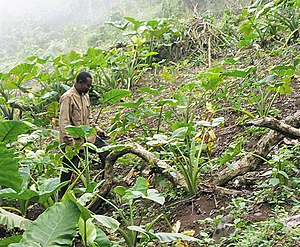
The Araceae are a family of monocotyledonous flowering plants in which flowers are borne on a type of inflorescence called a spadix. The spadix is usually accompanied by, and sometimes partially enclosed in, a spathe. Also known as the arum family, members are often colloquially known as aroids. This family of 140 genera and about 4,075 known species is most diverse in the New World tropics, although also distributed in the Old World tropics and northern temperate regions.
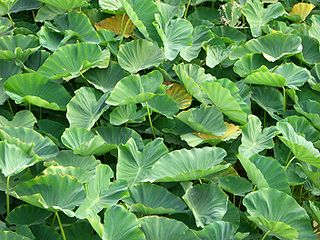
Colocasia is a genus of flowering plants in the family Araceae, native to southeastern Asia and the Indian subcontinent. Some species are widely cultivated and naturalized in other tropical and subtropical regions.

Corm, bulbo-tuber, or bulbotuber is a short, vertical, swollen underground plant stem that serves as a storage organ that some plants use to survive winter or other adverse conditions such as summer drought and heat (perennation).

In botany, a spadix is a type of inflorescence having small flowers borne on a fleshy stem. Spadices are typical of the family Araceae, the arums or aroids. The spadix is typically surrounded by a leaf-like curved bract known as a spathe. For example, the "flower" of the well known Anthurium spp. is a typical spadix with a large colorful spathe.
Elephant ear may refer to:

Xanthosoma is a genus of flowering plants in the arum family, Araceae. The genus is native to tropical America but widely cultivated and naturalized in other tropical regions. Several are grown for their starchy corms, an important food staple of tropical regions, known variously as malanga, otoy, otoe, cocoyam, tannia, tannier, yautía, macabo, ocumo, macal, taioba, dasheen, quequisque, ʻape and as Singapore taro. Many other species, including especially Xanthosoma roseum, are used as ornamental plants; in popular horticultural literature these species may be known as ‘ape due to resemblance to the true Polynesian ʻape, Alocasia macrorrhizos, or as elephant ear from visual resemblance of the leaf to an elephant's ear. Sometimes the latter name is also applied to members in the closely related genera Caladium, Colocasia (taro), and Alocasia.

Alocasia is a genus of rhizomatous or tuberous, broad-leaved, perennial, flowering plants from the family Araceae. There are about 90 accepted species native to tropical and subtropical Asia and eastern Australia. Around the world, many growers widely cultivate a range of hybrids and cultivars as ornamentals.

Taro is a root vegetable. It is the most widely cultivated species of several plants in the family Araceae that are used as vegetables for their corms, leaves, stems and petioles. Taro corms are a food staple in African, Oceanic, East Asian, Southeast Asian and South Asian cultures. Taro is believed to be one of the earliest cultivated plants.
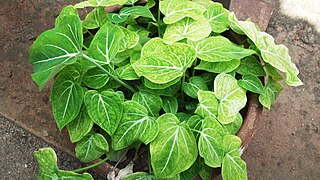
Caladium is a genus of flowering plants in the family Araceae. They are often known by the common name elephant ear, heart of Jesus, and angel wings. There are over 1000 named cultivars of Caladium bicolor from the original South American plant.

Eddoe or eddo is a tropical vegetable often considered identifiable as the species Colocasia antiquorum, closely related to taro, which is primarily used for its thickened stems (corms). In most cultivars there is an acrid taste that requires careful cooking. The young leaves can also be cooked and eaten, but they have a somewhat acrid taste.

Alocasia odora is a flowering plant native to East and Southeast Asia. In Manipur, India, its local name is hoomu. Traditionally, A. odora is sometime used as a medicine for the treatment of the common cold in North Vietnam.
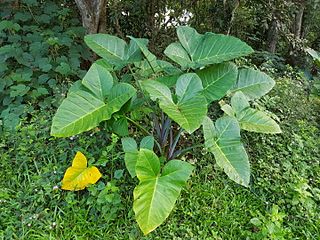
Xanthosoma sagittifolium(Tannia) is a tropical flowering plant from the family Araceae. It produces an edible, starchy corm. X. sagittifolium is native to tropical America where it has been first cultivated. Around the 19th century, the plant spread to Southeast Asia and Africa and has been cultivated there ever since. X. sagittifolium is often confused with the related plant Colocasia esculenta (Taro), which looks very similar and is also used in a similar way. Both plants are often collectively named Cocoyam.

Alocasia macrorrhizos is a species of flowering plant in the arum family (Araceae) that it is native to rainforests of Maritime Southeast Asia, New Guinea, and Queensland and has long been cultivated in South Asia, the Philippines, many Pacific islands, and elsewhere in the tropics. Common names include giant taro, giant alocasia, ʻape, biga, and pia. In Australia it is known as the cunjevoi.

Cyrtosperma merkusii or giant swamp taro, is a crop grown throughout Oceania and into South and Southeast Asia. It is a riverine and "swamp crop" similar to taro, but "with bigger leaves and larger, coarser roots." There are no demonstrably wild populations today, but it is believed to be native to Indonesia. It is known as puraka in Cook Islands, lak in Yap, babai in Kiribati, iaraj in the Marshall Islands, brak in Palau, babaʻ in the Marianas Islands, pula’a in Samoa, via kana, Pulaka in Lau, Lovo in Fiji, pulaka in Tokelau and Tuvalu, mwahng in Pohnpei, pasruk in Kosrae, simiden in Chuuk, swam taro in Papua New Guinea, navia in Vanuatu and palawan in the Philippines.
Xanthosoma brasiliense is a species of flowering plant in the Araceae. Common names include Tahitian spinach, tannier spinach, belembe, and Tahitian taro. It is one of several leaf vegetables used to make callaloo, and it may be called calalu in Puerto Rico.

Colocasia gigantea, also called the giant elephant ear or Indian taro, is a 1.5–3 m tall aroid plant with a large, fibrous corm, producing at its apex a whorl of thick, green leaves. In addition to its value as a starchy root vegetable—known by many names, such as taro, or arbi —the plant’s leaf stalk (petiole) is also used as a vegetable in some areas of Southeastern Asia and Japan.
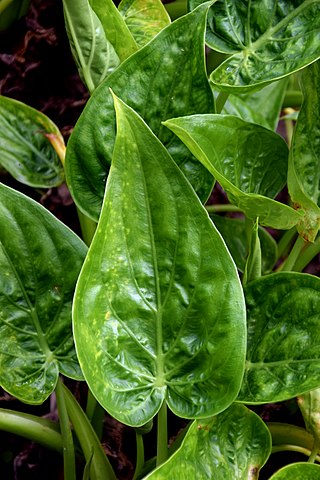
Alocasia cucullata is a species of flowering plant in the arum family known by the common names Chinese taro, Chinese ape, Buddha's hand, and hooded dwarf elephant ear. It is kept as an ornamental plant.

Montrichardia arborescens, the yautia madera, or moco-moco, is a tropical plant grows along river banks, swamps, or creeks to a maximum height of 9'. They consist of arrow shaped leaves that are food sources for animal species. The plant produces inflorescences which then leave a fruit of Montrichardia arborescens which is edible and can be cooked. Its fruiting spadices produces large infructescences, which contain about 80 edible yellow fruits.

Thaumatophyllum xanadu is a perennial plant belonging to the arum family Araceae and the genus Thaumatophyllum, formerly classified under the Meconostigma subgenus of Philodendron. This plant is native to Brazil, but is widely cultivated as a landscape plant in tropical, subtropical and warm temperate climates.
Xanthosoma caracu is a species of edible plant described by Karl Koch and Carl David Bouché. It is native to South America and cultivated in Puerto Rico.
